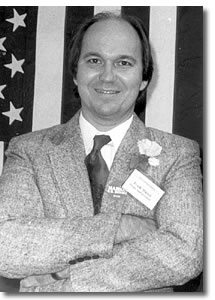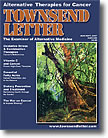In
1992, Congress created the Office of Alternative Medicine (OAM) within
the National Institutes of Health (NIH) to evalu-ate unconventional treatments
for
numerous illnesses. In 1997, Congress replaced OAM with the National Center for
Complementary and Alternative Medicine (NCCAM). Congress had given OAM an initial
budget of $2 million (which OAM's first director characterized as "homeopathic
funding") and had left decisions on which studies to fund largely in the
hands of NIH. In establishing NCCAM, Congress greatly enlarged the center's
budget and provided it with more autonomy in selecting and funding projects.
This special report, in two installments, reviews OAM's and NCCAM's
record in organizing evaluations of unconventional cancer treatment. The concentration
here on cancer is appropriate, because OAM and NCCAM came into being in response
to a study of unconventional cancer therapies in the US published by the Office
of Technology Assessment (OTA) in 1990. (OTA, an investigative arm of Congress,
was shut down after the Republicans gained control of Congress in 1994.)
For this update, I interviewed individuals in and outside the Federal government
deeply involved with the creation and operations of OAM and NCCAM. I e-mailed
variations of three questions to each:
1. What were your expectations
in helping to set up OAM and NCCAM?
2. How have OAM and NCCAM functioned afterward?
3. What do you envision for NCCAM during its second decade?
The first interview
follows.  Frank Wiewel, Founder, People
Against Cancer (PAC) Frank Wiewel, Founder, People
Against Cancer (PAC)
A musician with a rock band in the early 1980s, Frank Wiewel got involved with
alternative cancer therapy in the mid-1980s. His father-in-law had developed
cancer and was doing well under immuno-augmentative treatment at a clinic
in the Bahamas run by the late Lawrence Burton, PhD. Closure of Burton's
clinic by the Bahamian government in the summer of 1985 transformed Wiewel
into an advocate for Burton's patients. He led the patients' support
group between 1985 and 1990, and in this capacity, he played a key role in
getting Congress to authorize the OTA study of unconventional cancer therapy.
(Initially, the OTA intended to concentrate on Burton's approach.)
Since 1990, Wiewel has been a force behind the scenes in promoting government
evaluation of unconventional cancer treatment. Currently, he directs People
Against Cancer (PAC), in Otho, Iowa, a non-profit grass-roots organization
dedicated to obtaining clinical trials for CAM approaches in general. Wiewel,
respected worldwide as an authority on alternative cancer therapy, also offers
information on cancer treatment on a fee basis under The Alternative Therapy
Program; this program aims at finding the best cancer treatment for PAC members.
I had interviewed Wiewel for my column in the Townsend
Letter in 2004.1 At
that time, he had expressed disappointment over the lack of progress by OAM
and NCCAM in setting up trials for unconventional cancer therapy, and pointed
to directors of the NIH for frustrating efforts toward obtaining evaluations.
MC: In our interview three years ago, you said: "When Congress established
the OAM…we felt it might promote the organized evaluation of alternative
cancer therapies, broadening the base for later evaluations."2 Readers
of the Townsend Letter will be interested in hearing the specifics. Can you
provide them?
FW: The Office of Alternative Medicine was originally formed to "investigate
and validate" alternative forms of medical treatment. I was a founding
member of the National Advisory Board and Co-Chairman of the Pharmacological
and Biological Treatments Committee of the OAM.
Originally, the intent was to conduct field investigations of innovative treatments
for the major causes of death: cancer, heart disease, and AIDS. I proposed
that this be accomplished in a three-step system:
1. Find the major alternative
treatments.
2. Determine if there were sufficient numbers for evaluation.
3. Determine if the proponents were willing to work with us to assemble a
retrospective best case series, publishing the results after peer-review;
conduct a small
pilot study of 25 or more patients, again publishing the results after peer-review;
then, for those that show promise, conduct a large-scale study with matched
controls treated conventionally.
MC: Kindly recollect OAM's performance at
the start.
FW: Joseph Jacobs, MD, the first director of OAM, a bright, well-educated
man, clearly did not have a scholar's grasp of alternative medicine. He
was not personally an advocate of the use of alternative medicine. He admitted
to being not remotely aware of the depth or the scope of alternative medical
approaches to treatment of cancer, heart disease, and AIDS.
In the first year of OAM, I arranged for a site visit by Dr. Jacobs to
The Burzynski Research Institute (BRI) in Houston Texas, where we met with
Stanislaw
Burzynski, an MD and PhD who had been an assistant professor at Baylor
University. At Baylor, Dr. Burzynski had discovered non-toxic substances
in the blood,
tissue, and urine that signaled the cancer cell – which grows endlessly
out of control – to live and die normally. Burzynski called these substances
antineoplastons and established the Burzynski Research Institute to conduct
clinical trials and treat patients with them.
Dr. Jacobs was totally amazed to find a full-fledged company producing "natural" pharmaceuticals,
occupying a city block in Houston, and a full-scale medical practice, that
employed 75 MD and PhD-level doctors, scientists, and health care staff. During
that site visit, Dr. Burzynski provided us with a study of terminal brain tumor
cases, patients who were treated by antineoplastons and had remarkable recoveries.
Jacobs comment to me after the site visit was, "I know where I would
come if I had cancer."
Dr. Burzynski's work with antineoplastons presented an important opportunity
for OAM.
A licensed MD specializing in oncology with a PhD in biochemistry and
an assistant professor at a major university, Dr. Burzynski was well-qualified
for at least
a pilot study by OAM; and he was completely willing to cooperate with OAM.
Members of OAM's Advisory Board repeatedly suggested that Burzynski be
evaluated. To date, no such evaluation has ever been conducted.
MC: When I interviewed you in 2004, you related incidents and meetings
indicating that the NIH was dead set against doing the "right thing" with
OAM and NCCAM.3 What's your understanding of the NIH's attitude?
FW: The tiny OAM quickly became the center of a firestorm of controversy
within NIH. At its formation, Dr. Jay Moscowitz, acting director of NIH,
confided
to me that there was more press interest in OAM than in the entire NIH.
So from day one, NIH resented the OAM! After Harold Varmus, MD, took over
as
director of NIH, he quickly developed a hatred for OAM, reportedly advising
an NIH colleague: "You
can do two things for me. Get OAM and NCI (National Cancer Institute) off my
back." Evidently, Dr. Varmus, a Nobel laureate, heading what some have
characterized as the "black hole" of molecular biology, was not
about to allow OAM to do anything which would challenge the "status quo." In
no way would Dr. Varmus allow "carrot juice and coffee enemas" to
share the stage with "the dance of the electrons." Dr. Varmus did
allow Ruth Kirchstein, a long-term NIH bureaucrat, to ride herd on what he
regarded as a rogue office, to make sure that OAM did nothing of substance.
After six years of intense conflict and bureaucratic stonewalling, it was
apparent that OAM was not going to evaluate or validate anything substantial – certainly
not treatments for the major killers; cancer, heart disease, and AIDS. Instead,
OAM busied itself diligently planning trials to see if "massage therapy" made
dying AIDS patients feel better. Designing studies into the cause and cure
of cancer, heart disease, or AIDS was simply beyond OAM's vision! Embattled,
Dr. Jacobs resigned once he realized that OAM's problems were not so
much scientific as political, quipping, "I prefer the 'ticks' of
Connecticut to the 'Poli-ticks' of Washington."
MC: What happened after Congress replaced OAM with NCCAM, giving the new
center a much bigger budget and more autonomy in decisions on projects
than its predecessor?
Wasn't that expansion aimed at getting around the stonewalling at NIH?
FW: Some politicians did believe OAM could do more if it was enlarged and
officially designated a "National Center." The term "complementary" was
coupled with "alternative" as a way to make the new center palatable
to NIH and conventional doctors. (It linked carrot juice with chemo.) "Complementary
therapy" also suggested that such therapy would not replace (or compete
with) conventional medicine as a true alternative. And NIH bureaucrats found
someone who fit all their qualifications for director of NCCAM, Dr. Stephen
Strauss.
Dr. Strauss knew absolutely nothing about the world of alternative medicine.
He knew absolutely nothing about alternative treatments for cancer, heart
disease, and AIDS. He could not be called an advocate for CAM because he
did not personally
use it. Under his direction, no evaluations of alternative primary treatments
for cancer, heart disease, or AIDS were undertaken. Recently, Dr. Strauss
resigned from NCCAM and died soon thereafter. Now that Dr. Ruth Kirchstein
is acting
director of NCCAM, there's is no real risk that anything of value will
take place as long as she's on the job, keeping everyone at NCCAM "inside
the box."
MC: What about a second decade for NCCAM? No change for the better on the
horizon? Would it serve any medically useful purpose to fund NCCAM ten
more years?
FW: I hope the "mothership" will come back to earth and take those
involved with running NCCAM back to the planet where they belong. They certainly
don't belong on planet earth.
Sadly, the NIH has an institutionally obligated bias against alternative
medicine. As part of what I and others term the "Disease Industry Monopoly," they
are fixated on disease. Instead of embracing all innovative and alternative
ideas, they are fighting a desperate fight against proposed innovative and
alternative solutions.
After six years in "Looney Land," I was totally fed up with Washington.
Government officials there seem to know little about those they're elected
or appointed to serve – and seem to care even less.
This year, roughly 1.4 million Americans will be diagnosed with cancer;
560,000 will die, notwithstanding the best conventional treatments. During
their
lifetime, four in ten Americans will develop cancer. Increasingly, then,
we see our friends
and family members dying of cancer after devastating treatments feared
more than the disease itself. We are losing the war on cancer! We cannot
afford
to overlook any alternatives for any reason.

Townsend
Letter readers who wish to contact Frank Wiewel can reach
him at:
People Against Cancer
604 East St.
Otho, Iowa 50569
515-972-4444
Fax 515-972-4415
info@PeopleAgainstCancer.com
www.PeopleAgainstCancer.com
Note: Part Two of this special report will feature interviews with
former Congressman Berkley Bedell and Senator Tom Harkin

Notes
1. Cohen M. News from the cancer war: "back to square 1 on the
CAM front"; "metronomic therapy" advances on the
mainstream line. Townsend Letter. July 2004; 252:26-27.
2. Ibid.
3. Ibid.
|



![]()
![]()


 Frank Wiewel, Founder,
Frank Wiewel, Founder,